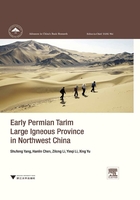
2
Tempo-Spatial Features of the Tarim LIP
Abstract: The study of the tempo-spatial features of the Tarim Large Igneous Province (Tarim LIP) can provide some good evidence of the limits of one of the world's Large Igneous Provinces (LIPs). The results of some recent research on the tempo-spatial features of the Tarim LIP will be addressed in this study. Through the systematical and detailed study of the spatial distribution and the precise dating and contact relationships between the main rock units in the Tarim LIP and the host rocks, the distribution of the Tarim LIP reaches over 2.5×105 km2, which is a Permian LIP in NW China. The temporal order of the Tarim LIP can be considered continental flood basaltic lavas in the Kupukuziman and Kaipaizileike formations (292-285 Ma) in the early stage, and layered mafic ultramafic complex, very rich magnesium ultramafic dike, mica-olivine pyroxenite breccia pipe, diabase dike, quartz syenite and bimodal dike (284–274 Ma) in the late stage.
Keywords: Temporal order; Spatial distribution; Field contact relationship; Chronology; Tarim Large Igneous Province (Tarim LIP)
The studies on temporal order and spatial distribution as well as on the tectonic implication for LIPs in the world provide a good contribution to geological history, geodynamics and large-scale V-Ti magnetite and Cu-Ni sulfide deposits, genetic links with the mantle plume and mass extinction, and even a good contribution to the understanding of the tectono-magmatism of the Eurasia plate and the mantle-crustal interaction in the Late Paleozoic (Coffin and Eldholm, 1994; Chung and Jahn, 1995; Wignall, 2001; Zhou et al., 2002; Morgan et al., 2004; Dobretsov, 2005; Xu et al., 2001, 2007, 2014; Halls et al., 2008; Pirajno et al., 2008; Bryan and Ernst, 2008). In this chapter, we will address the temporal framework and spatial distribution of the Tarim LIP, its stratigraphic succession, radiometric isotopic chronology and paleontology, contact relationships among huge-volume basaltic lavas, intrusive rocks such as of syenites, diabase dike swarm, tuff and volcanic breccia and sedimentary rocks; moreover, this study provides some appropriate constraints for magmatic evolution and temporal sequence.
The Tarim Basin in northwestern China, surrounded by the Tianshan, Kunlun and Altyn-Tagh orogenic belts (see Fig. 1.1), mainly consists of a Precambrian crystalline basement and Phanerozoic strata from the Ordovician to Neogene periods (Xinjiang BGMR, 1993; Jia, 1997; Zhang et al., 2003). Some important tectonothermal activities from the Archean period to the Paleozoic period have been identified in this area (Hu et al., 2000; Guo et al., 2005; Xu et al., 2005, 2009; Yang et al., 2006a, 2007; Long et al., 2010, 2011; Shu et al., 2011; Zhu et al., 2011), in which the early Permian magmatic event (known as the Tarim LIP) was regarded as the most important one (Yang et al., 2006a, b, c, 2007; Zhang C.-L. et al., 2008, 2010; Zhang Y.-T., 2010; Li et al., 2011). The Tarim LIP is widely distributed in the western and central part of the Tarim Basin, including the Keping, Bachu, Tabei (northern Tarim Basin), the Tazhong (central Tarim Basin) and the Taxinan (southwestern Tarim Basin) areas (Fig. 2.1). Large-scale continental flood basalt lavas erupted during the Early Permian period (Yang et al., 2006a, b, c; Chen et al., 2006; Li et al., 2008, 2011; Tian et al., 2010; Yu et al., 2011), constituting the main part of the Tarim LIP. A diverse assemblage of coeval intrusive rocks, such as layered mafic-ultramafic intrusions, mica-olivine pyroxenite breccia pipes, diabase and ultramafic dikes, quartz syenites, diorite, quartz syenite porphyry and bimodal dikes, occurred in the Tarim Basin.

Fig. 2.1 Spatial distribution of the Permian basalts of the Tarim LIP, locations of outcrop and borehole sections of the Tarim LIP, and spatial section lines of A-A' and B-B' almost cover the whole area of the Tarim LIP in the Tarim Basin (based on field observations, boreholes and seismic data) (Simply modified from Fig. 1b of Li et al., 2011)
Note: Yg=Yingan section, Kpz=Kaipaizileike section, Ssc=Sishichang section, Xhn =Xiahenan section, Xhz=Xiaohaizi section, NTU=northern Tarim Uplift, Wjl=Wajilitag section